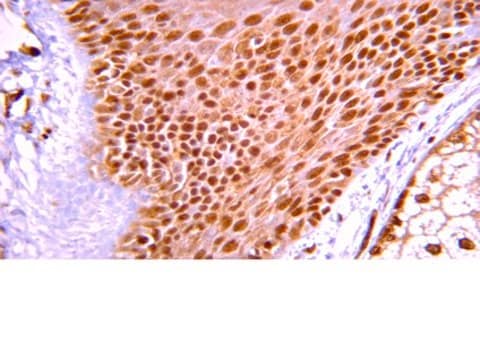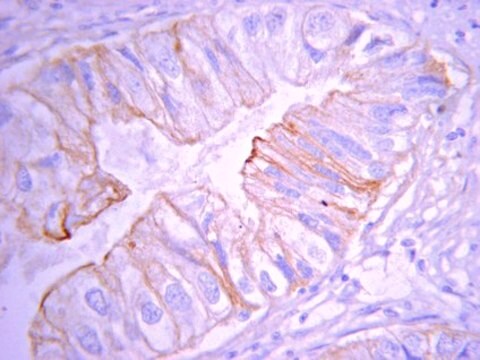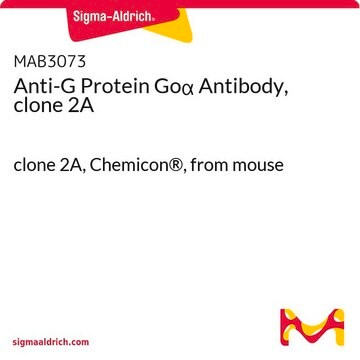04-478
Anti-phospho-STAT1 (Ser 727) Antibody, clone 12C5
clone 12C5, Upstate®, from mouse
Sign Into View Organizational & Contract Pricing
All Photos(1)
About This Item
UNSPSC Code:
12352203
eCl@ss:
32160702
NACRES:
NA.41
Recommended Products
biological source
mouse
Quality Level
antibody form
purified immunoglobulin
antibody product type
primary antibodies
clone
12C5, monoclonal
species reactivity
human
manufacturer/tradename
Upstate®
technique(s)
ELISA: suitable
western blot: suitable
isotype
IgG1
NCBI accession no.
UniProt accession no.
shipped in
wet ice
target post-translational modification
phosphorylation (pSer727)
Gene Information
human ... STAT1(6772)
Specificity
Recognizes phosphorylated domain of STAT1 on Serine727
Immunogen
KLH-conjugated synthetic peptide encompassing the surrounding amino acids of Serine727 on phosphorylated STAT1
Application
Anti-phospho-STAT1 (Ser 727) Antibody, clone 12C5 is a Mouse Monoclonal Antibody for detection of phospho-STAT1 (Ser 727) also known as signal transducer & activator of transcription 1 & has been tested in ELISA & WB.
Research Category
Epigenetics & Nuclear Function
Epigenetics & Nuclear Function
Research Sub Category
Transcription Factors
Transcription Factors
Quality
Routinely evaluated by immunoblot.
Target description
92 kDa
Physical form
Format: Purified
In 1 mL of PBS containing 0.09% sodium azide, PEG, sucrose, and 50% glycerol.
Subsequent thiophilic adsorption and size exclusion chromatography
Storage and Stability
2 years at -20°C from date of shipment. Avoid repeated freeze/thaw cycles, which may damage IgG and affect product performance.
Legal Information
UPSTATE is a registered trademark of Merck KGaA, Darmstadt, Germany
Disclaimer
Unless otherwise stated in our catalog or other company documentation accompanying the product(s), our products are intended for research use only and are not to be used for any other purpose, which includes but is not limited to, unauthorized commercial uses, in vitro diagnostic uses, ex vivo or in vivo therapeutic uses or any type of consumption or application to humans or animals.
Not finding the right product?
Try our Product Selector Tool.
Storage Class Code
10 - Combustible liquids
WGK
WGK 2
Certificates of Analysis (COA)
Search for Certificates of Analysis (COA) by entering the products Lot/Batch Number. Lot and Batch Numbers can be found on a product’s label following the words ‘Lot’ or ‘Batch’.
Already Own This Product?
Find documentation for the products that you have recently purchased in the Document Library.
H Nguyen et al.
The Journal of biological chemistry, 276(36), 33361-33368 (2001-07-05)
STAT1 must be phosphorylated on serine 727 to be fully active in transcription. We show that phosphatidylinositol 3-kinase (PI3K) and its effector kinase Akt play an important role in the serine phosphorylation of STAT1 and in the activation of gene
Rico K H Lo et al.
Cellular signalling, 18(3), 307-317 (2005-06-28)
The ability of the human prostacyclin receptor (hIP) to regulate the activities of signal transducers and activators of transcription (STATs) has not yet been documented. In the present study, we have delineated the mechanism by which hIP induces STAT3 phosphorylations
VEGF receptors on chronic lymphocytic leukemia (CLL) B cells interact with STAT 1 and 3: implication for apoptosis resistance.
Lee, Y K, et al.
Leukemia, 19, 513-523 (2005)
Christopher P Gayer et al.
The Journal of biological chemistry, 284(4), 2001-2011 (2008-12-03)
The intestinal epithelium is repetitively deformed by shear, peristalsis, and villous motility. Such repetitive deformation stimulates the proliferation of intestinal epithelial cells on collagen or laminin substrates via ERK, but the upstream mediators of this effect are poorly understood. We
Rama S Kota et al.
The Journal of biological chemistry, 280(35), 31076-31084 (2005-07-05)
Lipoprotein lipase (LPL) is a key enzyme in the hydrolysis of triglyceride-rich lipoproteins. In vascular diseases, such as atherosclerosis, inflammation plays an important role in the pathogenesis of the disease. We examined the role of LPL in modulating tumor necrosis
Our team of scientists has experience in all areas of research including Life Science, Material Science, Chemical Synthesis, Chromatography, Analytical and many others.
Contact Technical Service








